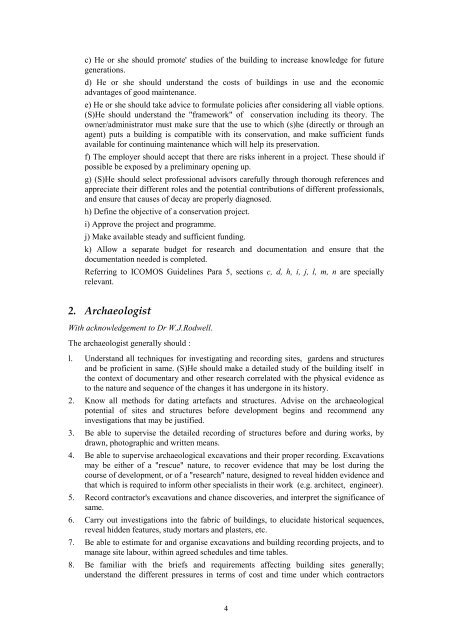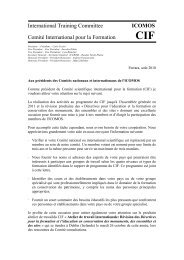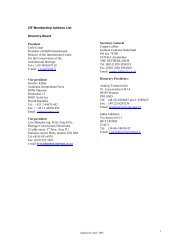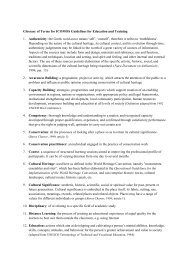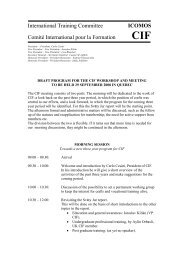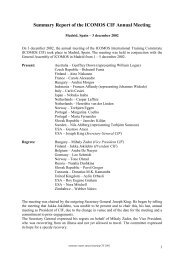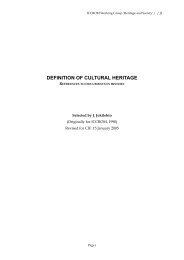COTAC Conference on Training in Architectural Conservation Multi ...
COTAC Conference on Training in Architectural Conservation Multi ...
COTAC Conference on Training in Architectural Conservation Multi ...
You also want an ePaper? Increase the reach of your titles
YUMPU automatically turns print PDFs into web optimized ePapers that Google loves.
c) He or she should promote' studies of the build<strong>in</strong>g to <strong>in</strong>crease knowledge for future<br />
generati<strong>on</strong>s.<br />
d) He or she should understand the costs of build<strong>in</strong>gs <strong>in</strong> use and the ec<strong>on</strong>omic<br />
advantages of good ma<strong>in</strong>tenance.<br />
e) He or she should take advice to formulate policies after c<strong>on</strong>sider<strong>in</strong>g all viable opti<strong>on</strong>s.<br />
(S)He should understand the "framework" of c<strong>on</strong>servati<strong>on</strong> <strong>in</strong>clud<strong>in</strong>g its theory. The<br />
owner/adm<strong>in</strong>istrator must make sure that the use to which (s)he (directly or through an<br />
agent) puts a build<strong>in</strong>g is compatible with its c<strong>on</strong>servati<strong>on</strong>, and make sufficient funds<br />
available for c<strong>on</strong>t<strong>in</strong>u<strong>in</strong>g ma<strong>in</strong>tenance which will help its preservati<strong>on</strong>.<br />
f) The employer should accept that there are risks <strong>in</strong>herent <strong>in</strong> a project. These should if<br />
possible be exposed by a prelim<strong>in</strong>ary open<strong>in</strong>g up.<br />
g) (S)He should select professi<strong>on</strong>al advisors carefully through thorough references and<br />
appreciate their different roles and the potential c<strong>on</strong>tributi<strong>on</strong>s of different professi<strong>on</strong>als,<br />
and ensure that causes of decay are properly diagnosed.<br />
h) Def<strong>in</strong>e the objective of a c<strong>on</strong>servati<strong>on</strong> project.<br />
i) Approve the project and programme.<br />
j) Make available steady and sufficient fund<strong>in</strong>g.<br />
k) Allow a separate budget for research and documentati<strong>on</strong> and ensure that the<br />
documentati<strong>on</strong> needed is completed.<br />
Referr<strong>in</strong>g to ICOMOS Guidel<strong>in</strong>es Para 5, secti<strong>on</strong>s c, d, h, i, j, l, m, n are specially<br />
relevant.<br />
2. Archaeologist<br />
With acknowledgement to Dr W.J.Rodwell.<br />
The archaeologist generally should :<br />
l. Understand all techniques for <strong>in</strong>vestigat<strong>in</strong>g and record<strong>in</strong>g sites, gardens and structures<br />
and be proficient <strong>in</strong> same. (S)He should make a detailed study of the build<strong>in</strong>g itself <strong>in</strong><br />
the c<strong>on</strong>text of documentary and other research correlated with the physical evidence as<br />
to the nature and sequence of the changes it has underg<strong>on</strong>e <strong>in</strong> its history.<br />
2. Know all methods for dat<strong>in</strong>g artefacts and structures. Advise <strong>on</strong> the archaeological<br />
potential of sites and structures before development beg<strong>in</strong>s and recommend any<br />
<strong>in</strong>vestigati<strong>on</strong>s that may be justified.<br />
3. Be able to supervise the detailed record<strong>in</strong>g of structures before and dur<strong>in</strong>g works, by<br />
drawn, photographic and written means.<br />
4. Be able to supervise archaeological excavati<strong>on</strong>s and their proper record<strong>in</strong>g. Excavati<strong>on</strong>s<br />
may be either of a "rescue" nature, to recover evidence that may be lost dur<strong>in</strong>g the<br />
course of development, or of a "research" nature, designed to reveal hidden evidence and<br />
that which is required to <strong>in</strong>form other specialists <strong>in</strong> their work (e.g. architect, eng<strong>in</strong>eer).<br />
5. Record c<strong>on</strong>tractor's excavati<strong>on</strong>s and chance discoveries, and <strong>in</strong>terpret the significance of<br />
same.<br />
6. Carry out <strong>in</strong>vestigati<strong>on</strong>s <strong>in</strong>to the fabric of build<strong>in</strong>gs, to elucidate historical sequences,<br />
reveal hidden features, study mortars and plasters, etc.<br />
7. Be able to estimate for and organise excavati<strong>on</strong>s and build<strong>in</strong>g record<strong>in</strong>g projects, and to<br />
manage site labour, with<strong>in</strong> agreed schedules and time tables.<br />
8. Be familiar with the briefs and requirements affect<strong>in</strong>g build<strong>in</strong>g sites generally;<br />
understand the different pressures <strong>in</strong> terms of cost and time under which c<strong>on</strong>tractors<br />
4


